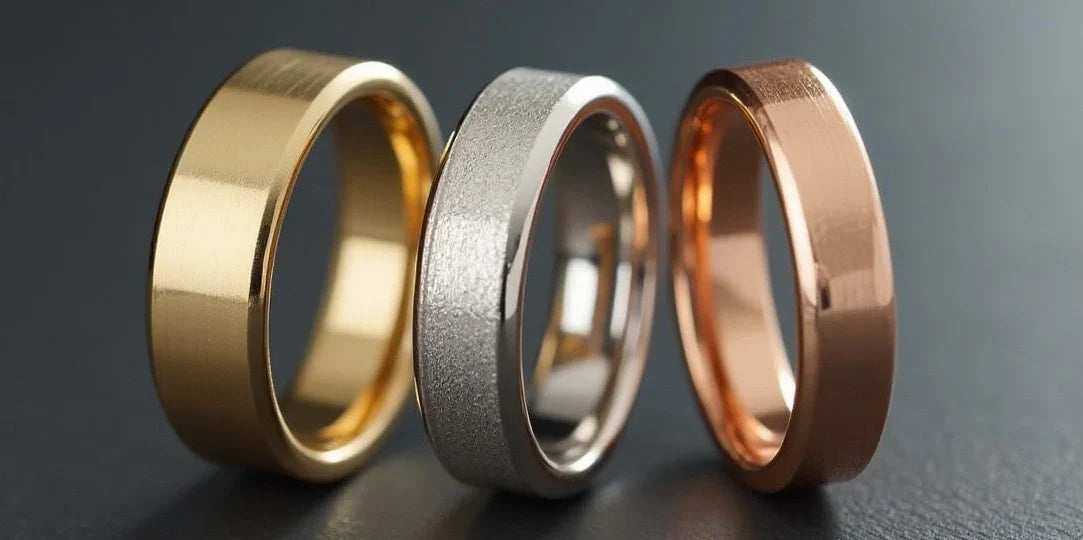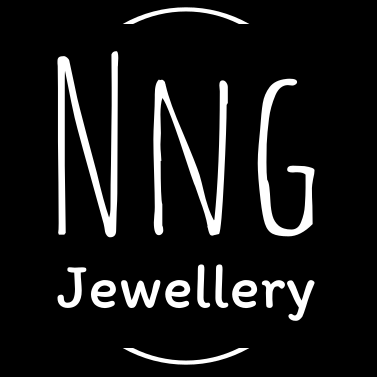
Unlocking the Secrets of Gold: Yellow, White, and Rose Gold Explained
Share
When shopping for gold jewelry, one of the first things you’ll notice is the variety of colors available—yellow, white, and rose gold being the most popular. But what creates these stunning hues, and how do they differ beyond their appearance? The secret lies in gold alloys, the mixtures of pure gold with other metals that define not only color but also durability, price, and suitability for different types of jewelry. In this article, we’ll dive into the world of gold colors and alloys, explore the differences between yellow, white, and rose gold, and help you choose the perfect shade for your next piece. Whether you’re eyeing a timeless necklace or a trendy bracelet, understanding gold alloys will elevate your jewelry-buying experience.
For a broader look at gold purity, check out our blog post Understanding Gold Karat Values: What Do 24K, 18K, and 14K Mean?. Now, let’s uncover the magic behind gold’s captivating colors!
What Are Gold Alloys?
Gold in its purest form—24K gold—is a soft, bright yellow metal that’s 99.9% pure. While its luster is unmatched, pure gold is too malleable for everyday jewelry. To make it stronger and more practical, jewelers mix it with other metals like copper, silver, zinc, nickel, or palladium. These mixtures, known as alloys, adjust gold’s hardness, durability, and—most noticeably—its color.
The karat (K) value indicates how much pure gold is in the alloy. For example, 18K gold is 75% pure gold (18/24 parts), while 14K gold is 58.5% pure gold (14/24 parts). The remaining percentage consists of alloy metals, which play a starring role in determining whether your jewelry is yellow, white, or rose gold. Curious about karat values? Our Everyday Jewelry Collection features durable 14K and 10K pieces perfect for daily wear.
Yellow Gold: The Classic Choice
What Is Yellow Gold?
Yellow gold is the closest to pure gold in appearance, retaining that rich, warm hue we associate with the precious metal. The yellow color comes from the high gold content, with alloys like copper and silver added to enhance strength without drastically altering the tone. The higher the karat, the more intense the yellow shade:
- 24K Yellow Gold: 99.9% pure gold, offering a deep, vibrant yellow. It’s rarely used in jewelry due to its softness but is prized for investment bars and coins.
- 18K Yellow Gold: 75% gold with 25% alloys (often copper and silver), delivering a bright yet slightly lighter yellow tone.
- 14K Yellow Gold: 58.5% gold with a higher alloy content, resulting in a subtler yellow that’s still warm and elegant.
- 10K Yellow Gold: 41.7% gold, with a muted yellow that may show hints of the alloy metals, like copper’s reddish tint.
Characteristics and Benefits
Yellow gold’s timeless appeal makes it a favorite for everything from engagement rings to heirloom pendants. Higher-karat yellow gold (18K and above) offers a luxurious shine, while 14K and 10K versions provide durability for everyday wear. It’s also hypoallergenic when alloyed with non-irritating metals like silver or copper, making it a safe choice for sensitive skin.
Best Uses
- Engagement Rings: 18K yellow gold strikes a balance between elegance and strength.
- Necklaces and Earrings: 14K yellow gold is ideal for daily wear; check out our Necklace Collection.
- Investment: 24K yellow gold is perfect for collectors and investors.
For more on gold’s historical significance, the World Gold Council offers fascinating insights into its enduring value.
White Gold: Sleek and Modern
What Is White Gold?
White gold has a silvery, platinum-like appearance, achieved by alloying yellow gold with white metals such as nickel, palladium, or zinc. To enhance its brightness and cover any yellowish undertones, white gold is often coated with a thin layer of rhodium—a shiny, durable metal. The karat value still applies:
- 18K White Gold: 75% gold with 25% white alloys, offering a premium look.
- 14K White Gold: 58.5% gold, slightly less lustrous but more durable.
- 10K White Gold: 41.7% gold, with a higher alloy content that may require thicker rhodium plating.
Characteristics and Benefits
White gold’s modern, understated elegance pairs beautifully with diamonds and other gemstones, making it a go-to for bridal jewelry. However, the rhodium plating can wear off over time, especially in lower-karat pieces exposed to daily wear. Re-plating is a simple fix at most jewelers. Note that nickel, a common alloy in white gold, may cause allergic reactions in some people—palladium is a hypoallergenic alternative.
Best Uses
- Wedding Bands: 18K or 14K white gold complements diamonds stunningly.
- Earrings: 14K white gold is durable yet chic.
- Statement Pieces: Its sleek finish suits bold, contemporary designs.
For a deeper dive into white gold’s properties, the Gemological Institute of America (GIA) has an excellent guide on gold alloys.
Rose Gold: Romantic and Trendy
What Is Rose Gold?
Rose gold, also called pink or red gold, gets its warm, reddish-pink hue from copper alloys. The more copper in the mix, the stronger the pink or reddish tone. Like other gold types, its karat value determines the balance:
- 18K Rose Gold: 75% gold with 25% copper (and sometimes silver), yielding a soft pink shade.
- 14K Rose Gold: 58.5% gold with more copper, deepening the rosy color.
- 10K Rose Gold: 41.7% gold, often showing a pronounced reddish hue due to higher copper content.
Characteristics and Benefits
Rose gold’s romantic, vintage-inspired look has surged in popularity, especially for engagement rings and trendy jewelry. The copper content makes it harder than yellow or white gold of the same karat, offering excellent durability. It’s also naturally hypoallergenic since it rarely contains nickel. The unique color flatters a wide range of skin tones, adding to its universal appeal.
Best Uses
- Engagement Rings: 18K rose gold offers a romantic glow.
- Bracelets: 14K rose gold withstands daily wear.
- Trendy Jewelry: 10K rose gold is affordable and stylish for bold designs.
Comparing Yellow, White, and Rose Gold
| Feature | Yellow Gold | White Gold | Rose Gold |
|---|---|---|---|
| Color | Warm yellow | Silvery white | Pinkish-red |
| Main Alloys | Copper, silver | Nickel, palladium, zinc | Copper, sometimes silver |
| Durability | Softer at higher karats | Moderate, rhodium wears | Harder due to copper |
| Best For | Classic, timeless pieces | Modern, diamond settings | Romantic, trendy styles |
| Maintenance | Minimal | May need re-plating | Minimal |
How Alloys Affect Gold’s Properties
- Color: Yellow gold keeps its natural hue with minimal alteration, while white gold relies on white metals and rhodium, and rose gold leans on copper’s reddish tint.
- Durability: Copper (rose gold) and nickel (white gold) increase hardness, while silver (yellow gold) adds strength without changing color much.
- Price: Higher karat golds cost more due to their gold content, but alloys can affect pricing—palladium in white gold, for instance, is pricier than copper.
- Allergies: Nickel in white gold may irritate sensitive skin; yellow and rose gold are safer bets with copper or silver.
Choosing the Right Gold Color for You
- Style Preference: Love classic elegance? Go for yellow gold. Prefer sleek modernity? White gold’s your match. Craving a romantic vibe? Rose gold wins.
- Occasion: White gold shines in formal settings, yellow gold suits versatile looks, and rose gold adds a trendy twist.
- Durability Needs: For daily wear, opt for 14K or 10K in any color—check our Everyday Jewelry Collection.
- Budget: 10K options are budget-friendly across all colors, while 18K offers luxury at a higher price.
Cultural Preferences in Gold Colors
- Western Cultures: White gold dominates bridal jewelry in the USA and Europe, while yellow gold remains a classic.
- India & Middle East: Yellow gold (often 22K or 24K) reigns supreme for its purity and tradition.
- Asia: Rose gold is gaining traction in China for its unique appeal, alongside 24K yellow gold for gifts.
Yellow, white, and rose gold each bring something special to the table, shaped by their unique alloys and karat values. Whether you’re drawn to the timeless warmth of yellow gold, the modern sheen of white gold, or the romantic blush of rose gold, there’s a perfect piece for every taste and purpose. Explore our Gold Jewelry Collection to find your ideal match, and don’t miss our guide on Gold Stamps and Certifications: How to Spot Fake Gold? for tips on ensuring authenticity.



